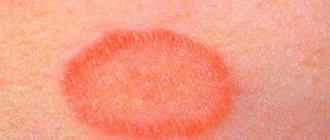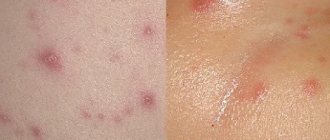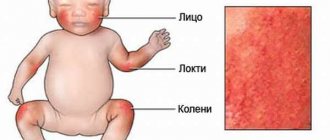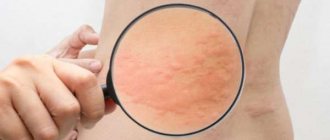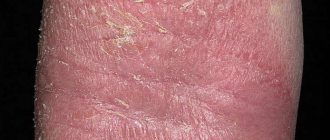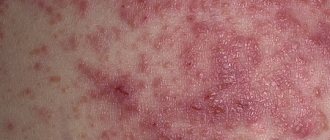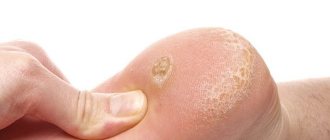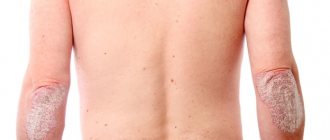Features of the disease
The disease often occurs in children and takes the form of an epidemic in children's institutions. The causative agents of this type of impetigo - streptococci, belong to the inhabitants of the normal microflora in humans, are transmitted through contact, through toys, household items, and personal belongings.
In adulthood, women, who have more delicate skin, are more likely to get sick than men. Fair-skinned blonds and redheads are also more likely to develop streptococcal impetigo. The surface layer of skin in these people is thin and is more easily overcome by bacteria.
In the international classification of diseases, 10th revision ICD-10, streptococcal impetigo is located in the section “Skin infections”, code L 01.
Weeping contagious impetigo (photo)
Prevention
Protecting yourself from streptococcus infection as an adult is quite simple. To do this, you need to carefully observe personal hygiene and strengthen your immune system. Exercising, eating well, staying outdoors for long periods of time and taking vitamins reduce the risk of infection by many pathogenic microorganisms.
Taking vitamins reduces the risk of streptococcal impetigo
It is more difficult to protect yourself from infection for people who have reduced immunity and young children. In this case, it is necessary to especially carefully observe hygiene and avoid injury to the skin, and if this happens, the wounds are treated with antiseptics. Every effort must be made to strengthen the immune system, which in the future will be able to independently fight not only streptococcus, but also other infections.
Important! Patients with streptococcal impetigo are isolated from others and undergo frequent cleaning using disinfectants.
You need to be especially careful if your child attends child care institutions. At the first signs of infection, it is necessary to visit a treating specialist and isolate the child from healthy children. Such strict sanitary surveillance measures make it possible to avoid epidemics in kindergartens and schools.
Forms
Impetigo is divided into:
- primary – developed during the introduction of streptococcal infection;
- secondary – streptococci are introduced by scratching, which causes itching in dermatitis and scabies.
The disease has a variety of forms. Most often children have to deal with the following types of streptococcal impetigo:
- slit-like (jammed);
- bullous;
- nail jam;
- syphiloid;
- ring-shaped;
- streptococcal diaper rash.
Elena Malysheva in this video will talk about streptococcal impetigo in more detail:
Causes
Staphylococci and streptococci surround the child almost everywhere. But this does not mean that every baby is at risk for developing impetigo.
Infection is promoted by:
- wounds and abrasions on the skin;
- heat, high humidity conditions;
- violations of hygiene rules;
- the period after illness when the immune system is weakened;
- elevated blood sugar, diabetes.
Mostly, the risk group includes children under 6-7 years of age, children who often visit a communal swimming pool, public baths. Impetigo often develops in children who suffer chronically or have recently suffered from other skin diseases.
Causes
Streptoderma infection is facilitated by destruction of the surface layer of the skin and disruption of its integrity. Streptococci are easily transmitted through maceration of the skin - swelling of the superficial stratum corneum under the influence of water, diaper rash, and injuries.
The main cause of infection with streptococcal impetigo is contact with a sick person. Factors contributing to the disease are:
- hot climate;
- high humidity;
- violation of personal hygiene;
- weakened immune system;
- skin diseases;
- metabolic disease.
An increase in the area of the lesion occurs due to self-infection during scratching. Pus from the burst blisters, containing a huge amount of streptococci, flows out of the burst pustules, and when scratched, spreads throughout the body.
Lesions are most often observed on open areas of the body - face, limbs, hands, feet. Phycten rashes in advanced forms of impetigo can occupy large areas and can be found on the torso, buttocks, thighs, and face.
Causes of impetigo
The main causative agents of infection are streptococcus and staphylococcus. The route of transmission is contact, through dirty hands, toys, clothes and other household items. Penetration of bacteria through mucous membranes is possible only when they are damaged, for example cracks or scratches.
Streptococcal impetigo in children occurs against the background of atopic dermatitis, eczema, and allergic contact dermatitis, since the immune system is already compromised. Maceration of the skin, hyperhidrosis (sweating), rhinitis or otitis with copious discharge are also favorable conditions for the onset of the disease.
The disease develops against the background of streptococcal infection. The transmission route is contact. Pathogenic microorganisms can live on dirty hands, household items, clothing and toys. The entry points for infection are cuts, abrasions and microcracks in the skin and mucous membranes. The likelihood of developing the disease increases with atopic dermatitis, eczema, prurigo, allergic contact dermatitis, as well as skin maceration, which can be caused by overheating, excessive sweating, rhinitis and otitis media.
Impetigo most often occurs as a primary disease, as a result of the action of pathogenic bacteria.
But the infection can also be concomitant - as a complication of dermatitis, chicken pox, lice, scabies.
Pathogens
The causative agents of impetigo are classified as opportunistic microorganisms. These are bacteria that constantly accompany humans and usually do not cause any diseases.
But in the presence of certain factors, microorganisms become pathogenic and cause various health problems.
Impetigo occurs as a result of exposure to two pathogens. One of them is Staphylococcus aureus, which lives on the skin and mucous membranes of humans.
It is characterized by fairly high resistance to antiseptics and environmental influences.
Another pathogen that causes impetigo is hemolytic streptococcus. The usual habitats of the bacteria are the respiratory tract, mucous membranes of the pharynx, nose, and organs of the genitourinary system.
Microorganisms are able to enter the body through the funnels (mouths) of hair follicles or through skin that has any damage.
Risk factors
There are various factors that increase the risk of developing skin diseases.
For example, if one of the family members is sick with impetigo, then the likelihood of other household members getting sick increases significantly.
What else increases the risk of infection:
- failure to comply with personal hygiene rules;
- poor sanitary conditions in places of residence;
- climatic factors – high humidity and elevated air temperature;
- a decrease in the body's defenses, including decreased immunity in pregnant women and children, and in the elderly;
- infectious and skin diseases in which the patient feels itching (chickenpox, eczema, scabies, pediculosis);
- metabolic problems;
- skin injuries (abrasions, scratches, microcracks, erosions);
- damage to the skin as a result of constant contact with aggressive substances (harmful working conditions);
- increased sweating.
The causative agents of the disease in question are staphylococci and streptococci. They provoke impetigo in a child only if there is damage to the epidermis. Even superficial scratches, small wounds and bites of blood-sucking insects can lead to the penetration of bacteria into the skin and the onset of an acute inflammatory process. Further spread of impetigo in children occurs due to the following conditions:
- scratching rashes;
- direct contact with an infected child;
- sharing clothing, toys, dishes and other items.
Predisposing factors to the spread of infection:
- warm and humid air;
- microtraumas on the skin;
- immunological disorders;
- deficiency of vitamins in the body;
- non-compliance with sanitary and hygienic rules;
- dermatitis.
Symptoms
The disease begins with redness, swelling of the skin and a rash of phlyctenae on it - small formations, the size of a millet grain, blisters (vesicles, pustules) filled with clear or purulent liquid. On average, the diameter of the conflicts is from 2 to 10 mm, but in some forms of streptococcal impetigo, the conflicts can reach the size of a pea, with a diameter of 2 cm, turning into blisters (bullas) filled with pus.
After a week, the conflicts burst, and in their place a light yellowish crust forms. After another 2 days, the crust dries out, falls off, and in its place remains a wet, erosive spot. The phlyctena may not open, but after 5-7 days it will dry out and disappear; after its disappearance, only redness and depigmentation of the skin will remain - a light spot on the skin, devoid of pigment.
General information about the disease
Impetigo is caused by Streptococcus aureus (Staphylococcus aureus), as well as group A betamolytic streptococci (Streptococcus pyogenes). Both of these bacteria may be present simultaneously in the infected area (impetigo vulgaris). Infection with Streptococcus aureus may follow a primary streptococcal infection. It is known that streptococcus aureus is the most common pathogen in developed countries, but betamolytic is the most common pathogen in less prosperous countries.
The initial phase of most diseases is streptococcal impetigo. However, during the development of the disease, staphylococci replace streptococci, that is, one type of disease turns into another - staphylococcal impetigo. While impetigo appears as pyoderma of uninjured skin, a secondary infection of already injured skin, called impetigo dermatitis, can also occur.
If we talk about non-bullous impetigo, it begins with a single erythematous macula, which quickly transforms into a pustule and bursts, leaving a yellow, erosive skin. This disease is asymptomatic, except that sometimes patients experience itching and mild pain. The infection spreads to nearby areas through direct seeding.
Bullous impetigo is characterized by the appearance of blisters that develop into a sensitive plaque under intact skin (at a depth of about 1 centimeter). As the disease progresses, the plaque breaks down and ruptures the skin, coming to the surface. Lesions may be localized or widespread on the body, most commonly the face, but this is not mandatory.
Diagnostics
Diagnosis of the disease is based on:
- on external examination;
- microscopic examination data allowing to differentiate streptococcal impetigo from other infectious skin diseases;
- study of the nature of skin damage that preceded infection.
Streptococcal impetigo is differentiated from syphilitic pemphigus, erythema, epidermolysis bullosa, eczema, and fungal infection.
We will tell you below how to treat impetigo in children and adults.
This video will tell you about the symptoms and diagnosis of impetigo:
Diagnosis of streptococcal impetigo
In typical cases of streptococcal and mixed strepto-staphylococcal impetigo, diagnosis is not difficult. You should just always remember that often the impetiginous process is secondary, superimposed on the underlying skin disease of a non-pyodermic nature. Therefore, in such cases, one must be careful regarding the final diagnosis, which can sometimes be clarified only after the phenomena of impetiginization have been eliminated.
Simple pityriasis of the face, or “dry pyoderma,” should be distinguished from seborrhea and seborrheic eczema (“seborrheids”). The latter is characterized by a yellow coloration of the rashes, severe inflammation, and often a feeling of itching; Usually, at the same time, the patient can detect symptoms of seborrhea on the scalp. “Dry pyoderma” occurs almost exclusively in children.
It is difficult to mix it up with any other disease, but you need to keep in mind that the same clinical picture of a seizure can be caused by both streptococci and yeast fungi and hyporiboflavinosis, as well as, naturally, various combinations of these factors. From the syphilitic mucous plaque, which is also sometimes localized in the corners of the mouth, the jam is distinguished by its initial phlyctena, pain, lack of opalescent color and inflammatory corolla along the periphery;
Pemphigus of newborns most often has to be differentiated from syphilitic pemphigus, from which it differs: the absence of blisters on the palms and soles (a localization very characteristic of syphilitic pemphigus), the absence of any other signs of congenital syphilis, often the presence of more or less severe general phenomena, etc. .;
We suggest that you familiarize yourself with Treatment and prevention of streptococcal infections
in doubtful cases, the contents of the blisters can be examined for spirochete pallidum, and appropriate careful examination of the mother and serological tests may be important. It should also be borne in mind that pemphigus in newborns in maternity hospitals sometimes has an epidemic nature.
The serpiginous form of streptococcal impetigo in some cases, especially when localized on the trunk and limbs, can be confused with Dühring's dermatitis herpetiformis, in which sometimes the rashes also have a serpiginous character. The absence of rashes typical of dermatitis herpetiformis, the limited nature of the lesion (cases of limited Dühring's dermatitis are very rare), the absence of general phenomena, as well as eosinophilia in the blood allow us to reject the diagnosis of dermatitis herpetiformis.
Related articles:
A dermatologist can identify streptococcal impetigo based on clinical signs. A photo of the skin (dermatoscopy) and a study of its acidity only confirm the diagnosis. To accurately determine the etiology of the disease, the contents of the vesicles are sown on nutrient media, and when the colony of bacteria grows, microscopy is performed.
If the disease often recurs, it makes sense to be examined by an immunologist so as not to miss any serious disorders. Skin bacterial diseases are the first bell indicating the scale of the problem.
In the process of collecting information about the disease, the doctor needs to differentiate it from folliculitis, ostiofolliculitis, vulgar impetigo, epidemic pemphigus, herpes simplex, and Duhring's dermatitis. Clinically, they all resemble streptococcal impetigo. A high-magnification photo of damaged skin helps to distinguish diseases from each other.
The patient is consulted by a dermatologist. To establish and confirm the diagnosis, the doctor collects anamnestic data, analyzes clinical signs, conducts a physical examination and refers the patient for additional examinations. As part of the diagnosis, dermatoscopy, skin pH analysis, bacteriological culture of discharge from superficial pustules, and immunological studies can be performed.
The disease is differentiated from folliculitis, ostiofolliculitis, vulgar impetigo, simple and allergic contact dermatitis, epidemic pemphigus of the newborn, herpes simplex, Dühring's herpetiform dermatitis.
Impetigo should be diagnosed by a dermatologist. Typically, an experienced specialist can make a diagnosis based on the results of a visual examination, since the disease has a pronounced clinical picture.
But sometimes additional research is required:
- the causative agent of infection is identified using laboratory tests by collecting material from the ulcer cavity;
- also perform dermatoscopy and determine the pH of the skin;
- in case of frequent relapses, it is possible to prescribe an immunological examination in order to identify malfunctions in the immune system.
Treatment of streptococcal impetigo in children and adults
The method of treatment depends on the type of impetigo, the aggressiveness of the strain of bacteria that caused the disease, and the timeliness of treatment. If infants and children under one year of age are ill, you cannot treat the child yourself; you must call a pediatrician at home.
In the early stages, with minor damage to the skin, local treatment is limited. In advanced cases of a common skin infection that has deeply affected large skin folds, causing long-term non-healing cracks, antibiotics are prescribed, the skin is treated, and the conflicts are opened.
For streptococcal infections, accompanied by changes in the blood count and deterioration of health, antibiotics are prescribed in injections or tablets for oral administration.
Therapeutic
Externally, rashes of small conflicts are treated with antiseptics. Solutions of salicylic, camphor alcohol, and 40% medical alcohol solution are used. Externally treat the rash with ointments containing antibacterial agents - Bactroban, chloramphenicol liniment, erythromycin ointment.
The pustules need to be treated 3 times a day for 10 days. And at the end of the course of treatment, the lesion is not washed with water for another 10 days, but wiped with an alcohol solution.
The condition for a quick recovery is to follow the doctor’s recommendations:
- compliance with hygiene rules;
- excluding treatment of damaged skin with water; the skin is wiped with a solution of salicylic alcohol to maintain cleanliness.
Medication
If there is no result of external therapy with antiseptic solutions, ointments, medications are prescribed in tablets. An important component of treatment are antibacterial agents that are sensitive to streptococci.
These medications include antibiotics:
- penicillin group;
- cephalosporin series;
- fluoroquinolones.
Penicillin antibiotics are effective against streptococci, but due to their ability to cause allergies in children, they are replaced with cephalosporins. The advantage of antibiotics in this group is their high efficiency and wide spectrum of activity.
Treatment with antibiotics is necessarily accompanied by vitamin therapy and the prescription of immunostimulants. In case of a widespread disease, a course of autohemotherapy is prescribed - injections are given subcutaneously or one’s own blood taken from a vein is injected into the muscle to stimulate the immune system.
Treatment of streptococcal impetigo at home is discussed below.
Traditional methods
In case of streptococcal impetigo, traditional medicine can effectively help get rid of the disease with the help of effective simple recipes. Traditional recipes are especially useful in the early stages of infection in simple cases that are not complicated by extensive rashes, suppuration, the formation of deep cracks, and erosions.
- Chamomile, sage, and calendula have anti-inflammatory properties. Mixtures of these herbs in any proportions can be brewed in a tablespoon per glass of water and drunk 3 times during the day, half a glass.
- Fresh calendula juice and an alcoholic infusion of the flowers of this plant are used to wipe the affected areas of the skin.
A treatment recipe using birch tar will help you cope with streptococcal impetigo. To make the ointment you will need:
- children's cream – 100 g;
- birch tar – 10-20 g.
The ingredients are mixed, heated in a water bath to 60 degrees, poured into a prepared clean container. The ointment is applied 2 times a day after treatment with a solution of baking soda heated to 40 degrees. After treatment with soda solution, do not wipe the skin; apply ointment after drying. The ointment is not rubbed into the skin or washed off.
Incubation period of impetigo
Infection occurs quite quickly. Already 2-5 days after the penetration of cocci into the cells, the first signs of infection appear: red spots or fluid-filled pimples appear on the skin, which soon burst and become covered with a yellow crust. The skin most often affected is the skin of the face, in particular the areas around the nose and mouth or the mucous membrane of the eyes.
A sick child is very contagious, and therefore all items for his personal use must be disinfected. He himself must be isolated from contact with healthy children and adults. You also need to make sure that the baby does not scratch blisters and ulcers, since impetigo quickly spreads from diseased areas of the body to healthy ones.
During the treatment period, it is necessary to change clean towels and bed linen every day. The sick person should be provided with separate bathroom amenities, if this has not been done before.
With timely and competent treatment, impetigo goes away safely. But only a qualified doctor can prescribe an effective treatment regimen.
What is impetigo and why does it appear in children?
Impetigo is a skin condition caused by infection. The causative agents of this disease are streptococcus or staphylococcus. The disease affects the upper areas of the skin, resulting in the formation of purulent blisters. Impetigo in children is very common for a number of reasons:
- There are a lot of kids in the team. In nurseries, kindergartens and schools, impetigo spreads at lightning speed, since the disease is transmitted by contact - through things.
- Unfavorable living conditions. Violation of sanitary and hygienic standards leads to the formation of purulent blisters on the child’s body.
- Other skin diseases. Eczema, dermatosis, atopic and contact dermatitis can trigger impetigo (see also:).
- Presence of wounds, bites and microcracks. Pathogens do not pose any danger until they enter the baby’s body through an open wound.
- Weakened immunity. The child’s body is already very susceptible to pathogens - streptococcus and staphylococcus (see also:). A child with a weakened immune system, for example, after antibiotic therapy, is at main risk.
Diagnosis and treatment of impetigo
The diagnosis is made by a dermatologist based on medical history and clinical manifestations. If there is doubt about the diagnosis, dermatoscopy is performed. Additionally, specific research methods are used: Gram staining of exudate smears (cocci are visible under a microscope), culture of the discharged bullae for flora and an antibiogram. Self-diagnosis and self-medication, taking into account the contagiousness of impetigo, are unacceptable. Impetigo is differentiated from chickenpox, dermatomycosis, herpes, sycosis, contact and herpetiform dermatitis.
Treatment of uncomplicated forms of impetigo is carried out on an outpatient basis. Therapy has two goals: to eliminate the cause of the pathology and to improve the patient’s overall well-being. Usually, external means are sufficient to stop the process: the lesion is treated with 2% camphor alcohol, the blisters after opening are treated with fucorcin, antibiotic ointments. Vitamin therapy, immunostimulants, and sodium deoxyribonucleate are prescribed in the background. All water treatments are prohibited. The course of treatment is 10 days. If the disease continues to spread, antibiotics are added according to individual regimens: orally or intramuscularly by injection. A diet without sugar-containing products is prescribed, since glucose is a favorable breeding ground for the spread of microbes. Prevention consists of following the rules of personal hygiene and social life. The prognosis is favorable for life. The recovery is complete.
Classification of impetigo
In dermatology, it is customary to classify impetigo depending on the cause of the disease and clinical manifestations. There are:
Hemorrhoids kill the patient in 79% of cases
1. Streptococcal
( contagious ) impetigo
: the cause is streptococcus, which most often affects the skin of children and women. A very common and contagious form of impetigo. Includes several varieties:
- lichen simplex (“dry” pyoderma) – occurs on the face of children and is considered an abortive form. It manifests itself clinically as erythematous pink spots with peeling. The elements resolve under sun exposure, leaving persistent depigmentation;
- ring-shaped impetigo - a feature of the pathology is the formation of bullae, which resolve in the central part with the formation of crusts, and continue to grow along the perimeter, forming an element resembling a ring;
- Bullous impetigo is the most dangerous type of the disease. A distinctive feature is the rash of bullae with purulent-hemorrhagic contents up to 2 cm in diameter, mainly on the extremities. The conflicts grow and open, forming “greasy” crusts. Nails are involved in the process. The patient’s general condition suffers (headaches, fever, malaise, fatigue), concomitant diseases worsen;
- slit-like impetigo (jam) - develops in people who sleep with their mouths open, through the corners of which saliva flows passively, as well as in those who have the habit of licking their lips. It is clinically manifested by a rash of pustules in the corners of the mouth, at the wings of the nose, and outside the palpebral fissure. Pustules erode in the form of a slit-like defect in the skin and mucous membranes. The surrounding skin is tense, painful, and difficult to epithelialize, since lip movements break thin epithelial films;
- vegetative impetigo - the disease is characterized by spontaneous spread of bursting blisters with the formation of erosions covered with purulent crusts;
- syphiloid impetigo - the disease is noted in newborns. A distinctive feature is the rash of phlyctenas on the buttocks and in the subgluteal area. Phlyctenas open, forming erosions with an infiltrated base, resembling chancre, and are resolved by the formation of crusts that leave no trace behind;
- intertriginous streptoderma - rashes are localized in large folds of the skin, where, due to aseptic conditions (sweat, weeping), continuous itchy and painful erosive surfaces with a rim of remaining epidermis along the periphery are formed. The boundaries of the lesion are clear, there is a tendency to peripheral growth;
- Impetigo of the mucous membranes is a rash of aphthae in the oral cavity, on the mucous membranes of the cheeks, gums, tongue, nasal passages, and mucous membranes of the eyes.
2. Staphylococcal impetigo
(ostiofolliculitis, Bockhart's impetigo) – occurs in men, children, and adolescents. Occurs at the mouths of hair follicles when the rules of basic cleanliness are not followed. If it persists for a long time without treatment, it transforms into a carbuncle. Available in two versions:
- bullous form (deep folliculitis) - it is caused by Staphylococcus aureus. It is manifested by the formation of a nodular-vesical rash (5 mm) around the hair follicles, the primary elements become denser, tend to penetrate into the deep layers of the skin, the vascular bed, therefore, in the clinic there are symptoms of intoxication, and the outcome of the process is a scar;
- non-bullous form (superficial folliculitis) - caused by white staphylococcus, characterized by small (1.5 mm) purulent blisters, has no tendency to spread, the primary elements quickly dry out into crusts, which, falling off, leave no trace.
3. Mixed
impetigo
(vulgar impetigo) – occurs when streptococcal impetigo is complicated by staphylococcus, when the appearance of conflicts is accompanied by itching, scratching, and the addition of a secondary infection. The rashes are multiple, covered with thick crusts, localized in the face, neck, joints, near the nipples of the mammary gland, and on the genitals. Bullae and erosions are painful, tend to spread (through a dirty towel, bed linen), and regional lymph nodes are involved in the process.
Diagnostic methods
Initially, the dermatologist conducts a visual examination of the sick baby, whose parents complained of the appearance of conflicts. Based on the description, the doctor draws some conclusions for himself, but is in no hurry to make an accurate diagnosis. Impetigo can often be confused with other diseases (for example, psoriasis, contact dermatitis or herpes), so the dermatologist will prescribe additional diagnostic procedures if necessary:
- blood sugar test;
- microscopic examination of a Gram smear;
- culture for bacterial flora;
- dermatoscopy, with which you can capture the condition of the skin in a photo;
- skin Ph test.
Sometimes, for a more accurate diagnosis of the disease, it is recommended to examine the child’s blood
Symptoms of impetigo
The clinical picture depends on the type of pathogen. Streptococci cause the appearance of painful, elastic red blisters up to 5 mm in diameter with serous-purulent contents. Over time, the blisters become painless, flaccid, and open, forming erosions and ulcers that resolve into honey-colored scabs. The life cycle of primary elements is up to 2 months. There are no typical localization sites. Children get sick more often due to lack of personal hygiene skills. Streptococcal varieties of impetigo are dangerous due to their complications due to lympho- and hematogenous spread of infection (tonsillitis, sepsis, scarlet fever, nephritis, rheumatism, myocarditis). A banal complication is panaritium.
Staphylococcal impetigo is characterized by small pustular rashes around the hair follicles, which explains the typical localization of the process. The severity of possible complications depends on the depth of the skin lesion: skin abscesses, phlegmon, carbuncle. Strepto-staphylococcal skin lesions manifest themselves in the form of multiple purulent conflicts on the surface of the skin and around the hair follicles, which resolve with the formation of massive crusts exposing the erosive surface, resulting in slight hyperpigmentation. A distinctive feature of this form of impetigo is the spread of the process with the help of “dropout foci” - new areas of healthy skin. Lymph nodes enlarge, become denser, and become painful on palpation. Any impetigo is very contagious.
Methods of treatment with folk remedies
Traditional methods of treating impetigo are not the main ones; official medicine considers them as an addition to treatment with medications.
Some traditional medicine can be used to strengthen the immune system during illness:
- arnica;
- sage;
- aloe;
- ginseng;
- Rhodiola rosea;
- decoction of rose hips.
To treat the affected areas, use Kalanchoe juice, infusion of comfrey or arnica grass, decoction of flaxseed, alcohol infusion of calendula, decoction of string.
For oral administration, use a decoction of medicinal herbs - plantain, string, calendula, elecampane, chamomile, sage.

